Intel Rocket Lake (14nm) Review: Core i9-11900K, Core i7-11700K, and Core i5-11600K
by Dr. Ian Cutress on March 30, 2021 10:03 AM EST- Posted in
- CPUs
- Intel
- LGA1200
- 11th Gen
- Rocket Lake
- Z590
- B560
- Core i9-11900K
Gaming Tests: Final Fantasy XV
Upon arriving to PC, Final Fantasy XV: Windows Edition was given a graphical overhaul as it was ported over from console. As a fantasy RPG with a long history, the fruits of Square-Enix’s successful partnership with NVIDIA are on display. The game uses the internal Luminous Engine, and as with other Final Fantasy games, pushes the imagination of what we can do with the hardware underneath us. To that end, FFXV was one of the first games to promote the use of ‘video game landscape photography’, due in part to the extensive detail even at long range but also with the integration of NVIDIA’s Ansel software, that allowed for super-resolution imagery and post-processing effects to be applied.
In preparation for the launch of the game, Square Enix opted to release a standalone benchmark. Using the Final Fantasy XV standalone benchmark gives us a lengthy standardized sequence to record, although it should be noted that its heavy use of NVIDIA technology means that the Maximum setting has problems - it renders items off screen. To get around this, we use the standard preset which does not have these issues. We use the following settings:
- 720p Standard, 1080p Standard, 4K Standard, 8K Standard
For automation, the title accepts command line inputs for both resolution and settings, and then auto-quits when finished. As with the other benchmarks, we do as many runs until 10 minutes per resolution/setting combination has passed, and then take averages. Realistically, because of the length of this test, this equates to two runs per setting.
| AnandTech | Low Resolution Low Quality |
Medium Resolution Low Quality |
High Resolution Low Quality |
Medium Resolution Max Quality |
| Average FPS | 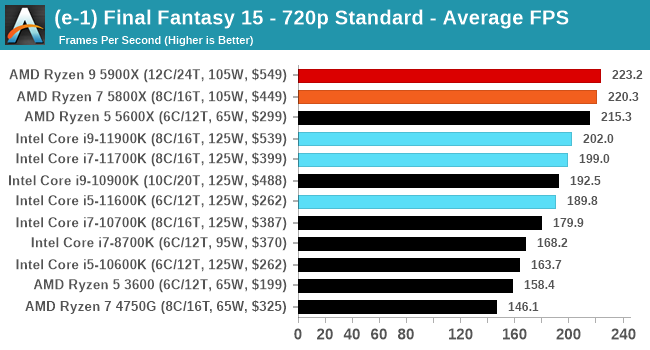 |
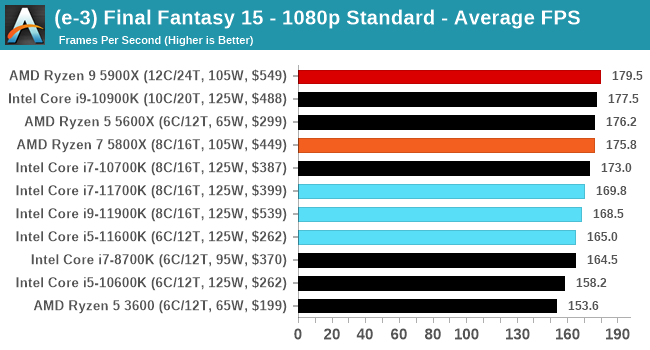 |
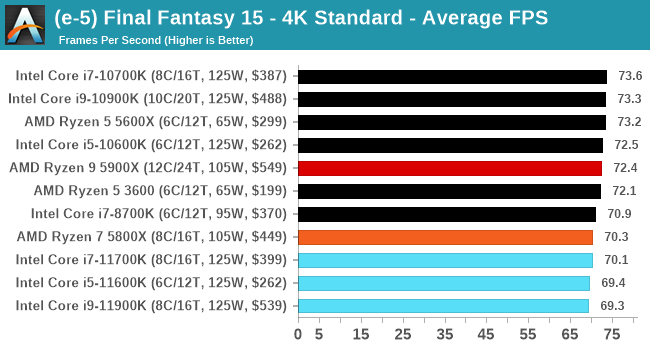 |
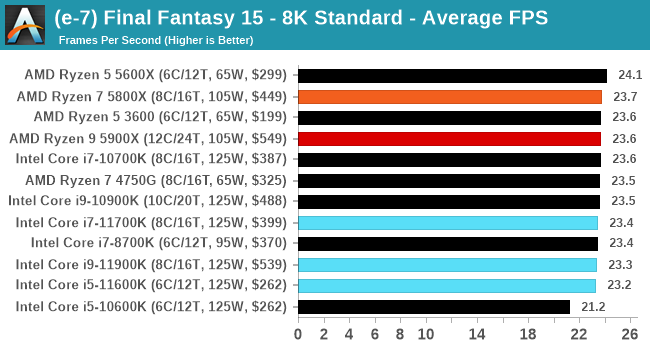 |
| 95th Percentile | 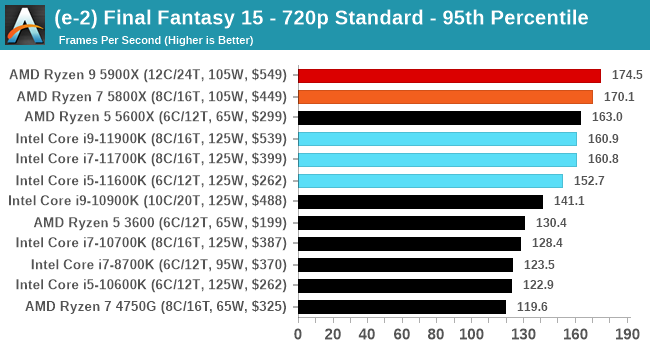 |
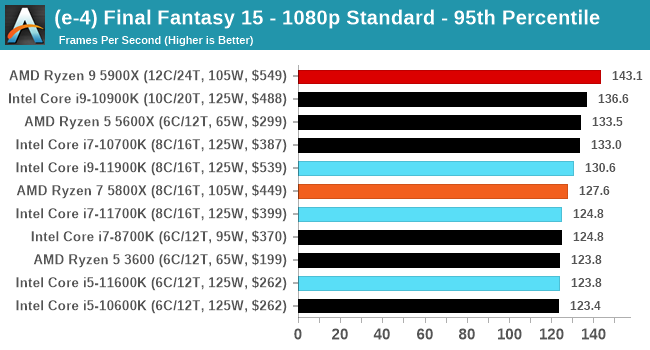 |
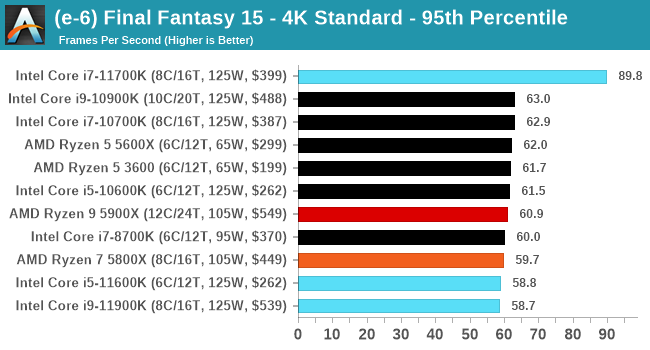 |
 |
All of our benchmark results can also be found in our benchmark engine, Bench.












279 Comments
View All Comments
macakr - Tuesday, March 30, 2021 - link
really? that bad? I can get that on a 15w Ryzen 4700u!Slash3 - Tuesday, March 30, 2021 - link
The 4700u mobile APU has a much stronger iGPU core, similar to that of Rocket Lake.Alistair - Wednesday, March 31, 2021 - link
Yeah it is that bad. Generally if you keep the resolution at 900p or 720p (or 50 percent scaling of 1080p, which is ~768p) the performance is ok. But it falls off dramatically at 1080p. No linear scaling here. Basically it is MUCH worse than laptop parts. I have DDR3600C16 so was expecting better. Oh well.Runeterra was barely playable at 1440p, just a basic card game, but the FPS shoots up dramatically at 1080p or lower, so that's fine. Would be nice to play Hearthstone and Runeterra with integrated graphics one day...
Tom Sunday - Thursday, April 8, 2021 - link
I am getting on the years and like to finally replacing my 13-year old Dell XPS 730x. Its time after being forced to replacing (3-times) PSU's, Motherboards, AIOs, GPU's and RAM. The new Intel i5 11600K holds interest. Will the 'integrated graphics' be good enough for just browsing the Net and watching old western or war movies on utube and with not doing any gaming? How good is the IGPU in this regard? Once I have more money I can hopefully buy a used discrete GPU 'over the table' next year at the local computer show? Will probably have my new system cobbled together by the local stripcenter PC shop and by one of the Bangladesh boys. So it will be good to sound somewhat intelligent discussing the hardware and not being pushed into what is cheap and in stock that day. Thoughts?Spunjji - Friday, April 9, 2021 - link
The iGPU on Rocket Lake will be fine for those purposes. However, so would the iGPU on the cheaper Comet Lake processors out there - they may be a better (cheap) option if you're going to buy now and upgrade later.Another option would be to go for a system based around the AMD Ryzen 5 3600 and re-use an existing GPU, which would also give you the option to upgrade the CPU again to something like a 5800X or even 5900X later. Personally, I'd go with that approach.
0ldman79 - Friday, April 16, 2021 - link
The integrated GPU is fine for movies and web.I've got a Skylake laptop with GTX 960M, it uses the iGPU until I fire up a game.
The h264 and h265 playback are accelerated through the iGPU, barely draws any power at all for video playback. The screen draws all the power. It'll play back 1080P 60 h264 or h265 all day long at under 2W. There are no issues using it for the web or anything else using integrated, it'll even play some games at lower settings, roughly 1/4 of a 750 Ti (960M) in gaming, though the newer chips will be slightly better.
Alexvrb - Tuesday, March 30, 2021 - link
Vega 11 is actually a bit slower than the latest 8 CU Vega found in Renoir/Cezanne. Not enough to catch up to Iris Xe, I don't think... but impressive given the smaller GPU and same power (or better). That's still GCN, too. If they release an APU with a ~10 CU RDNA2 GPU, it should give them a substantial boost... as long as bandwidth doesn't cripple it. Next gen memory should help, but they might also integrate a chunk of Infinity Cache. It has proven effective on larger RDNA2 siblings, giving them good performance with a relatively narrow memory bus.Oxford Guy - Wednesday, March 31, 2021 - link
Good ole iGPU distraction.How about the most important stuff? How about having it appear on the first page?
• performance per watt
• performance per decibel
Apples-to-apples comparison, which means the same CPU cooler in the same case for Intel and AMD.
That is important, not this obsession over a pointless sort-of GPU.
Jezwinni - Saturday, April 3, 2021 - link
I agree the iGPU is a distraction, but disagree on what declare the important things.Personally the performance for the price is the important thing.
Any extra power draw isn't going to blow up my PSU, make my electricity bills unmanageable, or save the world.
Why you consider the performance per watt most important?
0ldman79 - Friday, April 16, 2021 - link
Performance per watt on iGPU only matters in mobile devices, even then it's barely measurable.The iGPU is only going to pull 10W max, normally they peak around half that.